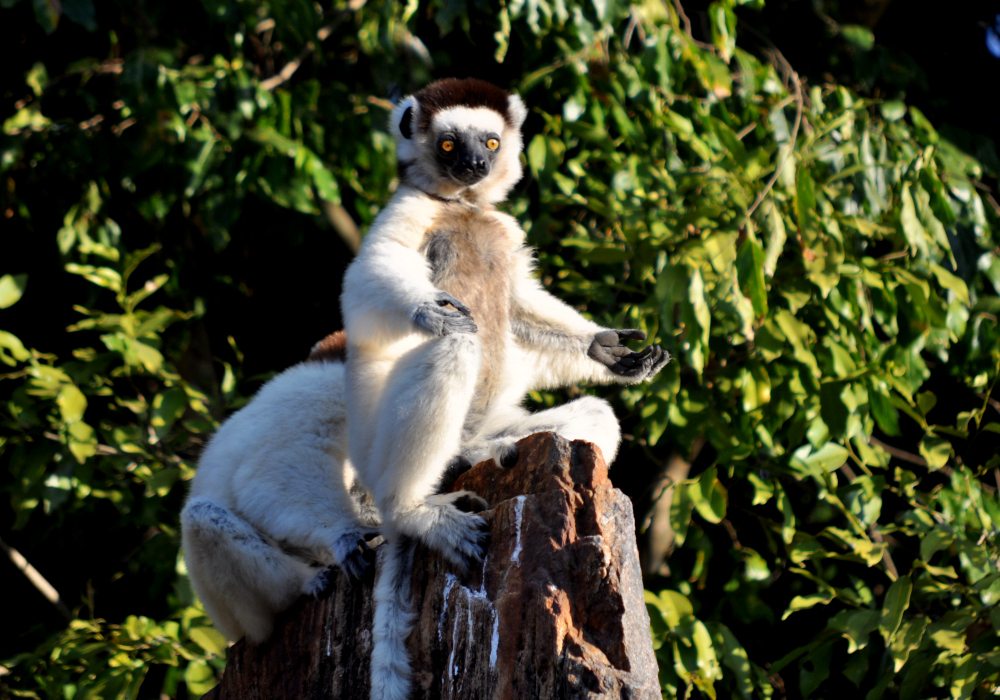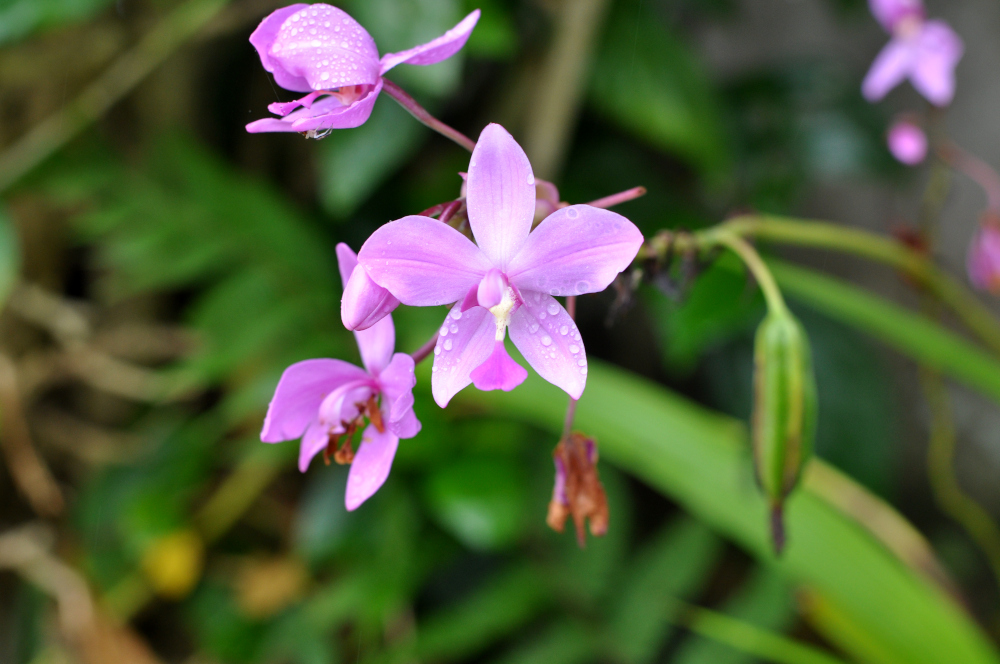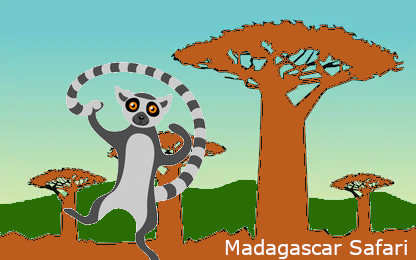- INTRODUCTION
- MALAGASY CULTURE
- MALAGASY TRADITIONAL SPORT
- MALAGASY CUISINE
- BEACHES AND RIVERS
- MONEY AND CREDIT CARDS
- PURCHASE TIPS
- SITES AND ACTIVITIES
- MONUMENTS
- MALASY HANDICRAFTS
- TIPS FOR TRAVELLERS
- MADAGASCAR CONNECTING FLIGHTS
- MADAGASCAR NATIONAL PARKS AND RESERVES
- FAUNA AND FLORA OF MADAGASCAR
- PUBLIC HOLIDAYS IN MADAGASCAR
- THE SOUTH WEST AND WESTERN REGIONS
- THE SOUTH EAST REGION
- THE NORTH WEST REGION
- THE NORTH EAST AND EAST REGIONS
- THE CENTRAL HIGHLANDS
FLORA AND FAUNA OF MADAGASCAR
THE FAUNA

Madagascar fauna differs from that of near Africa’s because of its endemic high rate of and the absence of big cats. There are over 100 000 species of invertebrates some of which are well known by collectors, like the biggest butterfly in the world, the comet whose trains may exceed 20 cm, or the great phasm (stick insect) whose female may be as long as 25 cm. But the award for originality could be awarded to the red and white giraffe beetle, thus dubbed for the long nape of their males. As for reptiles and amphibians, 95% of species are endemic. Frogs may have very unexpected colours from the military-like “uniform” of the Scaphiophryne Marmorata to the bright red Dicophus Antongilii. Just like lemurs, chameleons are emblematic of the great island, as in this country live the two-thirds of known species, from the shortest (less than 10 cm) to the longest (more than 70 cm). As for land tortoises, of which the radiated tortoise and the one with a “ploughshare”, they are endangered species which are particularly protected. Several families of the 350 inventoried bird species are endemic. The Vangidae are diversified into 14 species which have their own specific characteristics in terms of size, colours and beak shape. The same observation is made for the couas that one distinguishes the giant coua which moves on the ground and the crested coua which is considered as the most beautiful bird of the island. Of the 20 species of birds of prey, one can cite the snake eaters, the red owls and the Pygarque of Madagascar which is like the white headed 1merican eagle and for which there are only forty or so individuals left. Carnivores number 7 wild species, all of them are endemic. The biggest of all is the fosa, which, in profile, is thickset like a small puma and may be as long as 1.50 m, tail included. As for insectivores, the tenrec looks like a hedgehog which would be bigger than a rabbit in size, but without the ability to roll up into a ball. Lastly, the most representative mammals of Madagascar are the lemurs, primitive prosimians which have kept a few insectivore features. Diurnal or nocturnal lemurs, from the smallest one like a mouse to the biggest one, have been literally “exploded” into a myriad of species whose inventory has not been completed, as new species are still being discovered. It is the case for the Lepilemur Seali, the Lepilemur Mitsinjonesis, the 300 g nocturnal Mirza Zaza or the Microcebus Lehilahitsara. But the rarest malagasy lemur remains the aye aye, which have been saved from extinction in 1966. It is a weird animal which is said to have combined the teeth of a rabbit, the ears of a bat, the bristle of a boar, the hands of a monkey and the tail of a fox!
THE FLORA

Madagascar has fascinated several generations of naturalists to the extent that some of them, like Alfred Grandidier, practically devoted all their active life to studying its nature. From the arid bush of the south to the luxuriant vegetation of the east, the great island offers a wide range of altitudes, temperatures, rainfalls whose gradients combine to form several ecological niches. the West is the realm of baobabs of which Madagascar numbers 7 species against 2 for Australia and only one for the whole Africa. Here, the vegetation takes unexpected shapes such as the umbrella pine euphorbs, creepers whose stems show only in the rainy season, or the pachypodium which calls in mind the picture of a long -necked bottle. In the bush in the south, the didieraceans take the form of giant cactuses which may become impenetrable forests. As for pachypodium, either they creep on the ground, or erect their bole 5 or 6 m up to the sky. The bead-covered branches of the Euphorbia Alluandi account for their well justified nickname “sausage-tree”! As one army officer from the early days of french pacification said, “this world is unreal, not a plant, not a tree that looks familiar. One is walking in a forest, but a forest of marine dreams, a forest of lealess trees”. However, beware not to represent the south as a phantas- magorical wilderness reserved for those in search of strong sensations! Of all the 38 species of aloe, the Aloe Vaombe is perhaps one of the most beautiful plants of Madagascar. It may bear as many as one hundred clusters of bright red flowers that ablaze the barren surroundings. In the east and northeast forests, one has to open up one’s way through vegetation springing up from everywhere, from the rocks, ground or trunks and branches. In this area, more than one thousand varieties of orchids, of which some have memorable little anecdotes attached to them, have been numbered. Studying the Angraecum Sesquipedale which has a 35 cm long spur, Alfred Russel Wallace concluded that there must surely exist an insect with a proboscis that long to gather the nectar. It is only forty years later that the butterfly with the famous proboscis rolled under its head was discovered. It was named Xanthopan Morgani Praedicta as a tribute to the conviction of Wallace.
